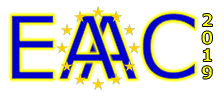Speaker
Description
Plasma wakefield accelerators using a long particle bunch as driver rely on a self-modulation process transversely modulating the long bunch into micro bunches that resonantly drive the wakefields [1]. Seeding the self-modulation at a level exceeding the noise level suppresses possible competing instabilities such as the hosing instability and leads to a phase reproducible modulation, needed for a high capture efficiency and quality preservation of the externally injected witness bunch.
We will present experimental results obtained with two seeding methods at AWAKE: Seeding with a relativistic ionization front, routinely used and seeding with an externally injected electron bunch, which was briefly tested.
We will quantitatively characterize the modulation of the proton bunch observed at AWAKE using time resolved transverse profiles recorded by a streak camera, analysing the charge per micro bunch and the strength of defocusing of protons within a few wakefields periods from the ionization front.
We attempt to infer the wakefield amplitude growth along the plasma and along the bunch from experimental results of defocused protons (time resolved and time integrated [2]) as well as from the energy gain of a probe electron witness bunch injected at various positions along the wakefield.

